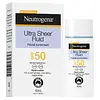What's inside
What's inside
 Key Ingredients
Key Ingredients

 Benefits
Benefits

No benefits
 Concerns
Concerns

 Ingredients Side-by-side
Ingredients Side-by-side

Water
Skin ConditioningIsopropyl Palmitate
EmollientNeopentyl Glycol Diheptanoate
EmollientOctocrylene
UV AbsorberButyl Methoxydibenzoylmethane
UV AbsorberEthylhexyl Triazone
UV Absorber4-Methylbenzylidene Camphor
UV AbsorberHydrated Silica
AbrasiveStearic Acid
CleansingCetearyl Alcohol
EmollientTriethanolamine
BufferingPolyglyceryl-3 Diisostearate
EmulsifyingAloe Barbadensis Leaf Juice
Skin ConditioningPhenoxyethanol
PreservativeXanthan Gum
EmulsifyingMagnesium Aluminum Silicate
AbsorbentChamomilla Recutita Flower Extract
MaskingTerminalia Ferdinandiana Fruit Extract
AntioxidantCamellia Sinensis Leaf Extract
AntimicrobialDimethicone
EmollientOenothera Biennis Oil
EmollientSimmondsia Chinensis Seed Oil
EmollientTocopheryl Acetate
AntioxidantVitis Vinifera Seed Oil
EmollientMethylparaben
PreservativeParfum
MaskingButylparaben
MaskingEthylparaben
PreservativePropylparaben
PreservativeIsobutylparaben
AntimicrobialTetrasodium EDTA
CI 77891
Cosmetic ColorantIron Oxides
CI 77004
Cosmetic ColorantWater, Isopropyl Palmitate, Neopentyl Glycol Diheptanoate, Octocrylene, Butyl Methoxydibenzoylmethane, Ethylhexyl Triazone, 4-Methylbenzylidene Camphor, Hydrated Silica, Stearic Acid, Cetearyl Alcohol, Triethanolamine, Polyglyceryl-3 Diisostearate, Aloe Barbadensis Leaf Juice, Phenoxyethanol, Xanthan Gum, Magnesium Aluminum Silicate, Chamomilla Recutita Flower Extract, Terminalia Ferdinandiana Fruit Extract, Camellia Sinensis Leaf Extract, Dimethicone, Oenothera Biennis Oil, Simmondsia Chinensis Seed Oil, Tocopheryl Acetate, Vitis Vinifera Seed Oil, Methylparaben, Parfum, Butylparaben, Ethylparaben, Propylparaben, Isobutylparaben, Tetrasodium EDTA, CI 77891, Iron Oxides, CI 77004
 Reviews
Reviews

Ingredients Explained
These ingredients are found in both products.
Ingredients higher up in an ingredient list are typically present in a larger amount.
Also known as Avobenzone, this ingredient is a chemical sunscreen filter that provides protection in the UV-A range.
Avobenzone is globally approved and is the most commonly used UV-A filter in the world.
Studies have found that avobenzone becomes ineffective when exposed to UV light (it is not photostable; meaning that it breaks down in sunlight). Because of this, formulations that include avobenzone will usually contain stabilizers such as octocrylene.
However, some modern formulations (looking at you, EU!) are able to stabilize avobenzone by coating the molecules.
Avobenzone does not protect against the UV-B range, so it's important to check that the sunscreen you're using contains other UV filters that do!
The highest concentration of avobenzone permitted is 3% in the US, and 5% in the EU.
Learn more about Butyl MethoxydibenzoylmethaneEthylhexyl Triazone is a modern chemical sunscreen that protects from UV-B radiation.
It is the most effective of existing UV-B filters, as it provides the highest level of photo-stable absorption. It protects from the entire UV-B range (280 to 320nm), with it's highest level of protection at 314nm.
Ethylhexyl Triazone is oil soluble, oderless and colorless, which mean it is able to be incorporated into a variety of different formulations.
It is not currently available within the United States due to slow changing FDA regulations. Outside of the US, it is used in formulations at concentrations up to 5%.
Learn more about Ethylhexyl TriazoneOctocrylene protects skin from sun damage. It absorbs UV-B with peak absorption of 304 nm. It is a common sunscreen ingredient and often paired with avobenzone, a UVA filter. This is because octocrylene stabilizes other sunscreen ingredients by protecting them from degradation when exposed to sunlight. Octocrylene is a photostable ingredient and loses about 10% of SPF in 95 minutes.
Octocrylene also acts as an emollient, meaning it helps skin retain moisture and softens skin. It is oil-soluble and hydrophobic, enhancing water-resistant properties in a product.
Those who are using ketoprofen, a topical anti-inflammatory drug, may experience an allergic reaction when using octocrylene. It is best to speak with a healthcare professional about using sunscreens with octocrylene.
The EU allows a maximum of these concentrations:
Learn more about Octocrylene